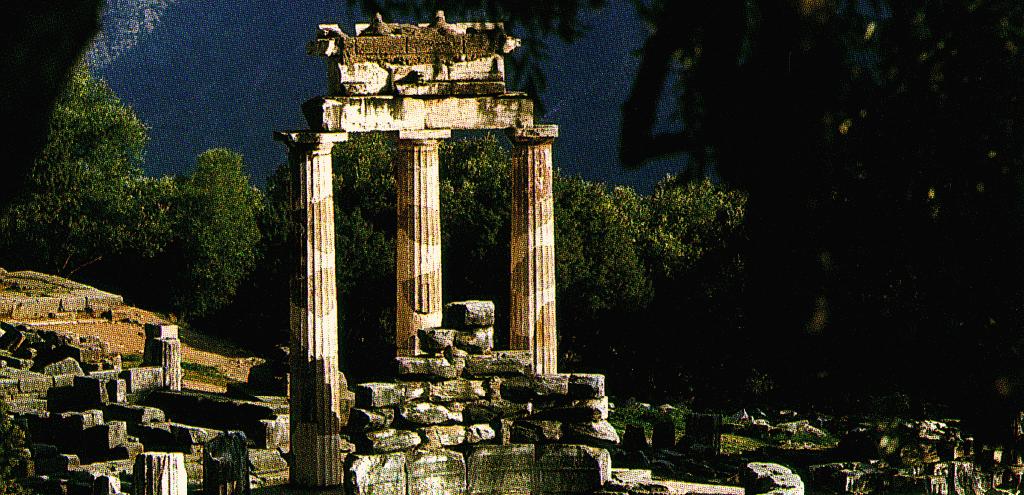
Mythology and History of the Oracle
The cave where the divinity Gaia (Mother Earth) used to utter prophecies guarded by her son, the serpent Python, dates from the second millenium BC (Mycenaen period). It was located on the way from Gulf of Corinth to Central and Northen Greece, in a region then called Pytho. When the god Apollo was an infant, he killed Python, at the same time abandoning Delphi to purify himself. After the purification took place, he returned to Delphi crowned and took over the Oracle, which from then on belonged to him. Apart from the mythical implications, this act symbolised the introduction of the worships of Delphios Apollo at Krisa (a town in Phokis, today Hrisso), by the seamen of Knossos. The god became known as Apollo Pythias and the area was called Delphi from that time on. At first the Oracle was under the strict domination of Krissa It was liberated in 590 BC, and it is from this date that the true history and fame of Delphi essentially began. A number of Sacred Wars broke out for control of the Oracle. The Phokians, Amphissans and even the Athenians vied to avail themselves of its great wealth, interfering with the independence of the priests and the little world that revolved about them. In 191 BC the Romans became masters of Delphi. This was a period of waves of pillaging raids but also attempts to revive the Oracle. However, nothing could halt Delphi's decline and eventually ceased to be regarded as the navel of the world.
Organization of the Delphic Force
A religious confederation, Amphictyonic Leage, composed of representatives (Sacred Scribes) of twelve Greek tribes administrated the sacred area and organized the Pythian Games and Delphic Festivals every four years with a performance of the Sacred Drama (whose main theme was the duel between Apollo and Python), music contests, paens and sacrifices in honour of the god. The members of the Amphictionic League met every spring and autumn to vote on decisions which were executed by the Senate. Worship at Delphi was headed by two priests of equal rank who were assisted by a series of free interpretrs and sacred slaves. The prophecy ceremony: Whoever wished to consult the Oracle was obliged to pay a tax, the "teleno", which gave him the right to approach the great altar of Apollo to offer sacrifices (boars,goats or bulls). Having purified herself in the water of the Kastalian Foundain, Pythia bent over the Navel of the Earth (the Sacred Stone), ate a laurel leaf and, inhaling the vapours emitted from the chasm, entered a state of ecstasy, uttering incoherent words. These were then composed into verses by the Priest, while the interpretes endeavoured to render some meaning out of the prophecy.
The archaeological site
(The first excavations began in 1838 and were completed in 1935) The Sanctuary of Apollo with the Treasuries (buildings where the city-states kept votive offerings and religious vessels), the temples and the peribolos (enclosure) lie on the south flank of Mt. Parnassos to your right if you are coming from Arahova. The center of the Sanctuary is dominated by the Doric temple of Apollo. The Sacred Way leads to the temple and is lined with Treasuries, monuments and offerings. Northwest of the temple is the theatre (5.000 seats) where the Delphic Festivals were held, which had as a central theme the representation of Apolloa's victory over the serpent Python. Rather further to the west and somewhat above the theatre lies the Studium where the Pythian Games took place every four years. To the right of the entrance to the Sanctuary is the Kastalian Fountain, where Pythia washed before speaking her prophecies, and on the left and below the road stands the Sanctuary of Athena; finds have shown that it had been dedicated as early as the Mycenaean era to a female deity. The tholos or rotunda, one of the most remarkable architectural constructions of antiquity, stands next to it. It is not known what this building was used for.
The Museum
The first building dates from 1902. The museum's collection consists exclusively of objects of all kinds from the Sanctuary of Delphi. Among its major works are: the navel of the world (a Hellenistic or Roman copy of the Sacred Stone), the Sphinx of the Naxians (550 BC), the statue of Antinous, the statue of Agias, the group of Thyiads (three colossal female figures portrayed dancing around a flowered column from the Sanctuary of Dionysos), the metopes from the Treasuries of Sicyon and Athens, the Karyatid and Zephyr from the Treasury of Siphnos, the bronze Charioteer, the head of Dionysos.